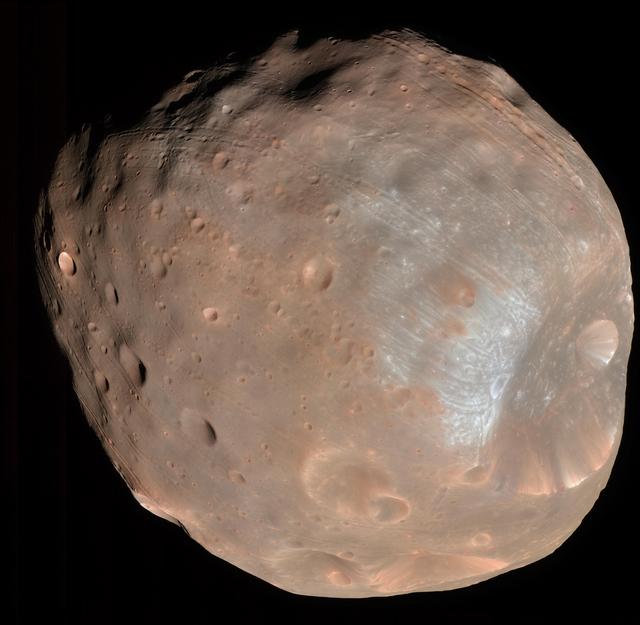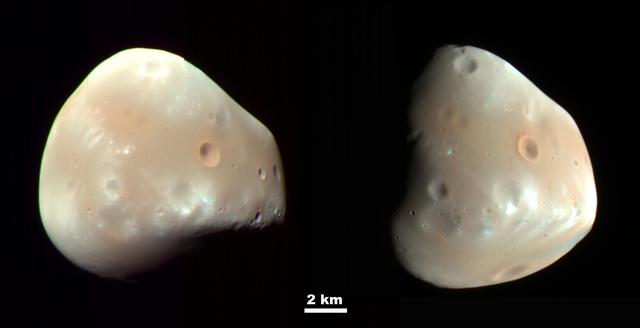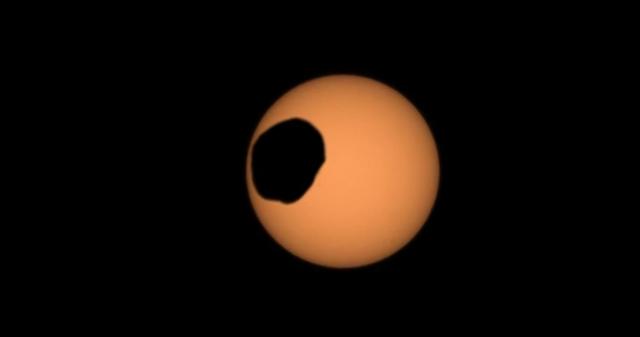The two tiny moons of Mars, Phobos and Deimos, may not look like much at first glance – just lumpy, cratered chunks of rock circling the Red Planet. But their odd shapes, strange orbits, and mysterious origins have puzzled scientists for decades. And now, with plans underway for human missions to Mars in the coming decades, understanding the role of these Martian moons has never been more important.
The thing is, these moons could play a critical role in supporting long-term human exploration in space. From in-situ resources on the asteroids to ideal locations for scientific observation and communications infrastructure, Phobos and Deimos might become stepping stones to Mars – and potentially keys to unlocking its ancient history.
Where Did Phobos and Deimos Come From?
The origins of Phobos and Deimos remain one of the most compelling open questions in planetary science. While both orbit Mars in neat, circular paths close to its equatorial plane, their bulk densities, surface materials, and spectral properties suggest a more complex history.
There are two dominant theories, each with far-reaching implications:
1. Captured Asteroids
This theory suggests that Phobos and Deimos are carbonaceous asteroids, likely from the asteroid belt, that were pulled into orbit by Mars’ gravity. Their surface compositions, similar to C-type asteroids, support this hypothesis. These dark asteroids are rich in primitive rocky material, similar to chondritic meteorites, and could offer insight into the early solar system.
But there’s a problem. For Mars to have captured these moons into their current circular and equatorial orbits, something would have needed to slow them down; possibly a thick Martian atmosphere that no longer exists. Without a mechanism for this orbital shift, the capture theory becomes less likely.
2. Giant Impact Scenario
Alternatively, some scientists believe the moons formed from Martian material ejected during a massive collision – a process similar to the formation of Earth’s Moon. A giant impact scenario would have created a disk of debris that coalesced into the two moons. Numerical models (see Rosenblatt et al.) support this scenario by showing how a massive collision could create a disk of debris around Mars, eventually coalescing into Phobos and Deimos.
This is further supported by the distinct difference in elevation between Mars’ northern hemisphere and southern hemisphere – a possible consequence of such an ancient impact. The distribution and orbital properties of the moons also align well with predictions from these simulations, making the giant impact model increasingly compelling in light of recent research.
This model would mean that the moons are partially made of Mars itself, offering a rare chance to study early Martian crust without landing directly on the Martian surface.
Why Their Origins Matter

Knowing how the moons formed isn’t just an academic exercise; it directly impacts their resource potential and what role they might play in future missions. If Phobos and Deimos are captured asteroids, they could contain organic compounds and volatile-rich materials from the outer solar system, potentially making them valuable fuel or life-support sources for long-term space operations.
On the other hand, if they are remnants of a giant impact, they may preserve ancient Martian material, possibly even older than what’s accessible on Mars today, which may unlock a geological time capsule with information about the early Martian crust. Understanding the moons’ composition also helps determine their structural stability, how they interact with tidal forces, and how they might respond to robotic or human activity.
This information is essential when evaluating their feasibility for long-term platforms, lander missions, or even human outposts. The difference in origin could also dictate how materials are distributed beneath the surface, influencing where and how we explore them.
What Makes Phobos & Deimos So Special?
Unlike larger, geologically active moons like Europa or Enceladus, the Martian moons are small, quiet, and ancient. But that’s exactly what makes them useful:
- They preserve the earliest solar system material
- Their low gravity and lack of atmosphere make landings easier
- Their unique composition and orbits provide clues about solar system dynamics
These moons could also serve as testbeds for future missions to other small bodies or asteroid belt targets. And, because of their proximity to Mars, they offer a controlled environment for studying planetary protection protocols, contamination risks, and tidal destruction scenarios.
What Resources Could Be Found on Phobos and Deimos?

Phobos and Deimos are not just scientific curiosities; they may as well be valuable assets for future exploration, as we’ve mentioned above. Here’s what we could potentially find on their surfaces:
1. Martian Ejecta
Studies suggest that meteor impacts on Mars have launched fragments of its surface into space, many of which eventually landed on the nearby moons. These fragments could include preserved Martian meteorites, which could provide pristine samples of the Martian crust. Some of this material may even predate what’s accessible on the Martian surface today. If analyzed, it could help scientists identify biosignatures, investigate Mars’ geologic evolution, or trace back the conditions that once supported a more habitable environment.
2. Primitive Carbonaceous Materialaster
If the moons are indeed captured asteroids, they may contain untouched carbon-rich material from the early solar system. This type of carbonaceous material is often linked to the presence of organic molecules and water-bearing minerals. These volatiles could potentially be harvested in the future for oxygen, fuel, or water, making these moons not just interesting scientifically but also practically useful for sustaining deep space missions.
3. Regolith and Dust Layers
Phobos and Deimos are blanketed with thick layers of fine-grained regolith, much of it likely produced by constant asteroid impacts. The dust also includes distinctive blue materials and scattered rocky material from Mars itself or beyond. This surface layer could preserve a time capsule of solar system history, potentially revealing how dust and debris move through space or even how Mars has interacted with its environment over billions of years.
4. Stable Platforms for Long-Term Use
Thanks to their low gravity and absence of atmosphere, both moons offer favorable conditions for long-term operations. Their surfaces are well-suited for robotic systems, equipment depots, or outposts that support future human missions to Mars. A platform on one of the moons could operate for years with fewer engineering challenges than planetary surfaces, making them ideal for scientific monitoring or even refueling missions.
5. Strategic Positioning
The current orbits of Phobos and Deimos allow for nearly constant line-of-sight communication with Mars. A lander or orbital platform stationed on the Mars-facing side of Phobos could monitor atmospheric activity, dust storms, or even track rovers and landers on the surface. This positioning is also beneficial for real-time data relay and could serve as a forward operating base for surface missions.
The MMX Mission – What’s Happening Next?
Japan’s Martian Moons eXploration (MMX) mission, led by JAXA, is scheduled to arrive in 2025. It’s the most ambitious attempt yet to unlock the secrets of Phobos and Deimos – both scientifically and strategically.
The MMX mission is designed to:
- Orbit both Phobos and Deimos to conduct extensive observations of their orbits, surfaces, and environments
- Land on Phobos, using advanced imaging and terrain mapping to identify a safe and scientifically valuable sampling site
- Collect at least 10 grams of regolith from Phobos’ surface using a specialized coring tool that drills down approximately 2 cm
- Deploy a rover jointly developed by CNES (France) and DLR (Germany) to explore the local geology and assist in sample selection
- Conduct remote sensing, including spectroscopy and surface imaging, to better understand composition, space weathering, and potential resource distribution
- Return the sample to Earth in a dedicated capsule scheduled to arrive in 2029, allowing laboratory-based analysis of Martian moon material for the first time in history
In addition to these objectives, MMX will perform multiple flybys of Deimos, collecting data that could inform future landing missions.
But why is this mission critical? Because it will allow scientists to test longstanding theories about the moons’ origins, whether they are captured asteroids or formed from Martian debris following a giant impact.
These samples could contain primitive solar system materials, organic compounds, or even ancient Martian ejecta, which makes them invaluable for both planetary science and resource utilization. The findings from MMX could influence future strategies for exploring not just Mars, but small celestial bodies across the solar system.
Strategic Role in Human Missions

As NASA and other agencies plan for human exploration of Mars in the 2030s, Phobos and Deimos could become critical waypoints. They could:
- Offer natural radiation protection
- Serve as logistical hubs or fuel depots
- Provide materials for in-situ resource utilization (ISRU)
A long-term lander platform on Phobos could support high-bandwidth communication with Earth, monitor Martian atmosphere, and relay data for surface missions. Visibility calculations done using the SPICE system show that a lander on the Mars-facing side of Phobos would have a continuous view of both Mars and Earth. This could enable simultaneous monitoring of Mars’ surface and space weather conditions.
The Long-Term Value of Phobos and Deimos
At first glance, Phobos and Deimos may seem like little more than rocky leftovers orbiting Mars. But the closer we look, the more they surprise us. Their unique orbits, surface materials, and potential for future missions make them more than just satellites; they could be some of the key players in the future of planetary exploration.
As space agencies like JAXA and NASA push the boundaries of Martian science, these moons offer something rare: stability, access to valuable materials, and a strategic position for observation and communication. With each study and mission, we come a step closer to turning their mystery into a meaningful part of our interplanetary future.